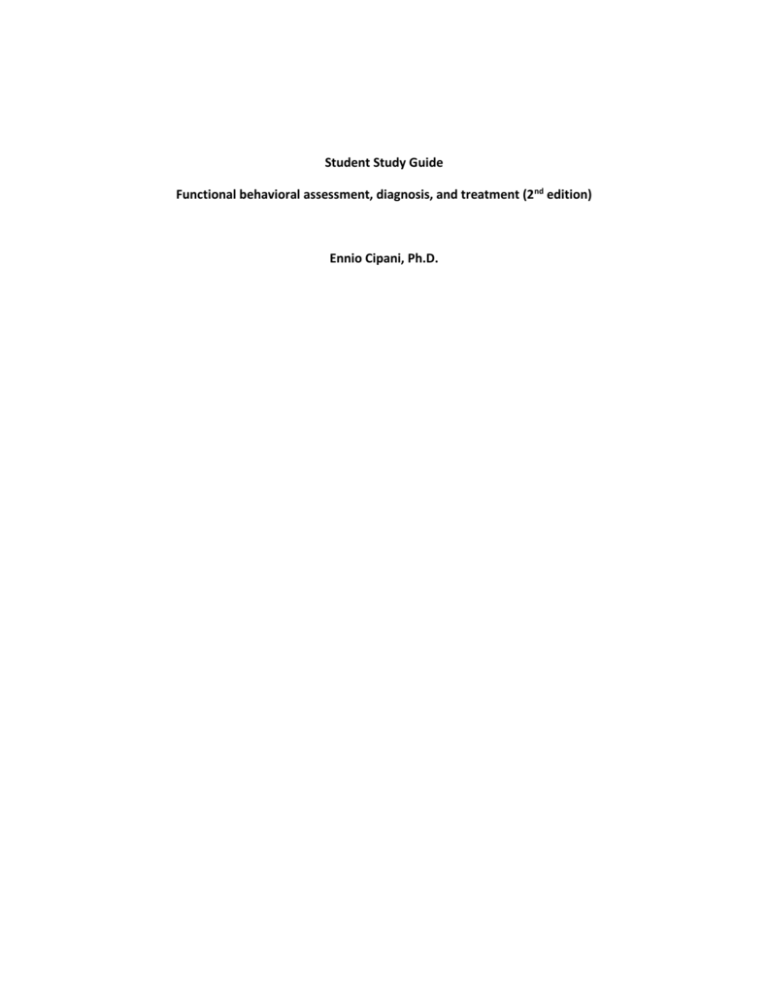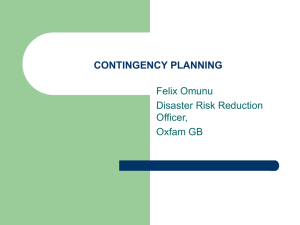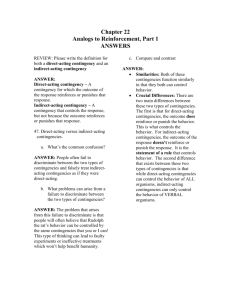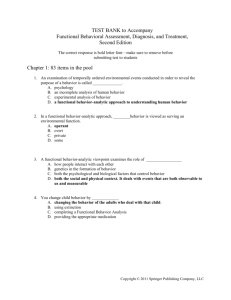Student Study Guide Functional behavioral assessment, diagnosis
advertisement

Student Study Guide Functional behavioral assessment, diagnosis, and treatment (2nd edition) Ennio Cipani, Ph.D. Chapter 1 On page 4, a number of hypothetical examples of a functional behavior-analytic approach are provided. Examine the case of Milton. Why does Milton pinch other clients? Does staff have something to do with that behavior? Starting on page 5 the contrast between positive and negative reinforcement contingencies is explicated. Study the hypothetical examples portraying individuals with various behavior problems delineated on page 4. Then illustrate how a problem behavior (specify the topography or form of behavior) can serve both a positive reinforcement function and then how the same form of behavior can serve a negative reinforcement function. Provide an example of a direct access function. Now provide an example of a socially mediated function. If food is an effective reinforce, what would be a direct access behavior? What might a socially mediated access behavior look like? If getting one’s hand stuck in a glass jar is an aversive event, describe what a direct escape behavior would be (hint- it’s breakable)? What about a socially mediated behavior that would also result in the hand being removed from the jar. Discuss what the establishing operation for an access functions is. Then contrast the EOs for access functions with establishing operations involved in escape functions. Delineate how a problem behavior of some topography can be functional under both states of deprivation and states of aversion. Provide one example of each type of EO (deprivation state vs aversive condition) and how the behavior produces a contingency that abolishes that EO. Read the section on- contrived contingencies produce a function from pages 24 to 26. What is the relevance of this section of the book? Provide your thoughts on the case of Polly, the five-year-old child described on page 27. Chapter 2 What are your thoughts on the “case of the intimate disclosure”? Do you think such unsolicited comments about one's sexual history would be tough to treat (i.e., eliminate) via the removal of people’s attention (maintaining contingency)? How does this case relate to the previous chapter’s discussion about contrived contingencies? On page 43, a trigger analysis for target problem behaviors is described. What is the advantage of this method for examining low-rate behaviors? What information (with respect to contextual variables- EOs) must the clinician have before using such a technique? On pages 46 to 47, I present three questions one should answer to determine whether a specific access or escape function is plausible. Explain what information each question seeks, in terms of zeroing in on the suspected contingency What are some of the problems with descriptive assessment data as it is commonly used, e.g., The often used A-B-C chart. How does the trigger analysis with behavioral description presented in this book differ from that? How would you use such a method (trigger analysis with behavioral description) for discerning the function of a problem behavior? Provide some hypothetical entries for a selected EO of your choice. Be able to describe the four conditions used in the functional analysis of behavior model developed by Dr. Brian Iwata and his team at Johns Hopkins University, published in 1982. You should be able to delineate the procedural requirements for implementing each condition. How is a pair-wise comparison testing of a specific hypothesis different from the above. What are the advantages and disadvantages of each? On page 66, the case of “when I say “no”” is described. Discuss the three test conditions that were compared; does the data make sense to you, and how? What does it say about the function of the problem behavior and how a 15- minute delay procedure ameliorates such an effect? What is the utility of an eco-systemic assessment of classroom contingencies? What information might this yield? Chapter 3 Generate problem behaviors found in school, home or community settings that reflect both SME and SMA functions. Delineate what the EO condition is, and how the problem behavior is efficient in producing an abolishing condition, i.e., relevant reinforce Generate problem behaviors found in school, home or community settings that reflect both DE and DA functions. Delineate what the EO condition is, and how the problem behavior is efficient in producing an abolishing condition, i.e., relevant reinforce. Contrast how direct functions are different from socially mediated functions both for access and escape behaviors. On page 89, a classic study by Solnick, Rincover and Peterson (1977) examined the effectiveness of timeout. The researchers found that time out did not work for the target behavior (decreasing its occurrence). Explain why the six-year-old girl with autism exacerbated her level of tantrum behavior, to produce the timeout. On page 93, an example of a 1.2 DA diagnosis regarding food scavenging is given. Explain why such behavior is a direct access function. Can food scavenging also be maintained by a socially mediated function? Explain how such a behavior might serve an attention function. How is the EO different in the DA case versus the attention function? Discuss the case of a hypothetical student Dolly and how some appropriate behaviors do not result in attention while an inappropriate behavior does. On page 103, a real-life case is explained in terms of how eloping from the facility results in this client getting soda. Explain how such a function, especially in light of the establishing operation, is an example of a 2.3 SMA diagnosis. On page 105 I provide a case of an individual who all staff said that the function of his problem behavior was getting people to restrain him. What was the maintaining contingency? Explain why was the restraint a requisite for getting this reinforcer. How does running away from the facility meet a 3.1 DE function-escape from unpleasant social situations (see page 108)? What is the wacky contingency? Explain how an instructional mismatch creates a contextual condition under which escape behaviors become likely. Explain the case of “shut up and leave me alone!” Found on page 170 On page 121 the hypothetical case of a student “I’m bored!” is presented. Why does this child engage in property disruption? Chapter 4 Explain what the section on page 135 entitled “disable one function, enable another” involves. Explain why chain interruption (the procedure) is usually necessary for problem behaviors that involve direct access functions. What are the four types of options for developing/strenthening an alternate behavior for DA functions? Explain how each one would be implemented for a given target problem behavior serving a DA functions On page 138, a real-life case involving a client who pushed and shoved to get to the refrigerator is explained. Delineate the strategy for reinforcing the alternate behavior was implemented. How is the option of reinforcing an access mand different from the replacement behavior option involving an alternate direct access form? How would you use the Omission training option for DA functions? How would you use the Premack contingency option? For SMA problem behavior functions, extinction is recommended on page 145. What does that mean in terms of staff or care provider behaviors required for implementing behavioral treatment? Explain the Reverse Premack Principle found on page 146 and how such can be used to disable the target behavior function. Explain how an access mand replacement behavior option can be used for socially mediated access functions Explain the DRO group contingencies used in the hypothetical case of Billy found on page 149 Examine the case of the hypothetical individual who rips his clothes off so that staff will give him new ones (page 151)? Explain how omission training can be used to progressively increase his tolerance of non-preferred clothing. s Explain the “Lays potato chip” example with how the Premack contingency was utilized (page 153). On page 161 I address a specific tool that can be used to determine the possible extinction burst for socially mediated escape functions. Please explain that method. Appendix A Contrast a misdirected contingency diagnosis with an inept repertoire diagnosis for classifying the potential replacement behavior. Which one would need contingency manipulations only and why? Describe the basic elements of an experimental test to determine if the replacement behavior is lacking as a result of an inept repertoire, or due to misdirected contingencies. On what behavior is reinforcement contingent upon in the control condition? What behavior gets reinforced in the test condition? Why is this conducted? Present a graph of data that reflects a misdirected contingency classification for a hypothetical replacement behavior. Do the same for an inept repertoire. Describe what a faulty discrimination diagnosis is. On page 293, I provide another use for experimental tests- with respect to DSM traditional diagnostic classifications. I also have two podcasts that address this topic and are available at http://behaviortherapist.podbean.com/category/behavior-analysis/ . Once you listen to these, what are your impressions of the use of such tests for the traditional classification system? Appendix B Explain “Why Artie cannot learn.” What are the implications for instructional programs that use observational learning approaches when working with learners like Artie? Appendix C Look at the last section in this Appendix- guidelines for application. Explain the procedure used for developing receptive labeling. Why do point prompts sometimes not work?







